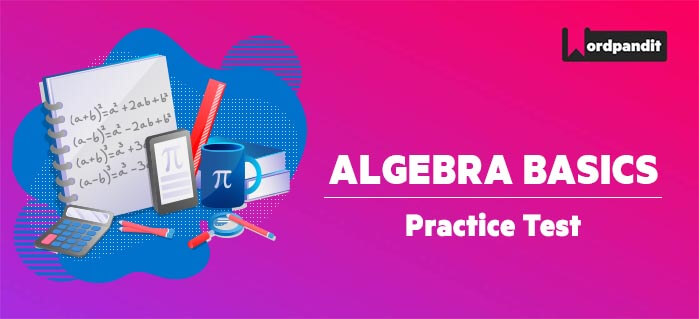- This is an assessment test.
- To draw maximum benefit, study the concepts for the topic concerned.
- Kindly take the tests in this series with a pre-defined schedule.
Algebra: Basics Test-7
Congratulations - you have completed Algebra: Basics Test-7.You scored %%SCORE%% out of %%TOTAL%%.You correct answer percentage: %%PERCENTAGE%% .Your performance has been rated as %%RATING%%
Your answers are highlighted below.
Question 1 |
If p ≠q, then which of the following statements is true?
$ \displaystyle \frac{p+q}{1}=\sqrt{pq}$ | |
$ \displaystyle \frac{p+q}{2}<\sqrt{pq}$ | |
$ \displaystyle \frac{p+q}{2}>\sqrt{pq}$ | |
all of the above |
Question 1 Explanation:
$ \displaystyle \begin{array}{l}Arithmetic\,\,\,\,mean\,\,\,(AM)\,\,\,=\frac{p+q}{2}\\Geometric\,\,\,\,mean\,\,\,\,\left( GM \right)\,\,=\sqrt{pq}\\As\,\,\,\,AM>GM\\\frac{p+q}{2}>\sqrt{pq}\end{array}$
Question 2 |
$ \displaystyle \left( f+\frac{1}{f} \right)\left( f-\frac{1}{f} \right)\left( {{f}^{2}}+\frac{1}{{{f}^{2}}}-1 \right)\left( {{f}^{2}}+\frac{1}{{{f}^{2}}}+1 \right)$
is equal to the
is equal to the
$ \displaystyle {{f}^{6}}+\frac{1}{{{f}^{6}}}$ | |
$ \displaystyle {{f}^{8}}+\frac{1}{{{f}^{8}}}$ | |
$ \displaystyle {{f}^{8}}-\frac{1}{{{f}^{8}}}$ | |
$ \displaystyle {{f}^{6}}-\frac{1}{{{f}^{6}}}$ |
Question 2 Explanation:
$ \displaystyle \begin{array}{l}=\left( f+\frac{1}{f} \right)\left( f-\frac{1}{f} \right)\left( {{f}^{2}}+\frac{1}{{{f}^{2}}}-1 \right)\left( {{f}^{2}}+\frac{1}{{{f}^{2}}}+1 \right)\\=\left( {{f}^{2}}-\frac{1}{{{f}^{2}}} \right)\left[ {{\left( {{f}^{2}}+\frac{1}{{{f}^{2}}} \right)}^{2}}-1 \right]\\=\left( {{f}^{2}}-\frac{1}{{{f}^{2}}} \right)\left( {{f}^{4}}+\frac{1}{{{f}^{4}}}+1 \right)\\={{f}^{6}}-\frac{1}{{{f}^{6}}}\end{array}$
Question 3 |
If p, q are two positive real numbers and p1/3 = q1/3, then which of the following relations is true?
p20=q15 | |
p3=q | |
p =q4 | |
p3=q4 |
Question 3 Explanation:
$ \displaystyle \begin{array}{l}{{p}^{\frac{1}{3}}}={{q}^{\frac{1}{4}}}\\\Rightarrow {{\left( {{p}^{\frac{1}{3}}} \right)}^{12}}={{\left( {{q}^{\frac{1}{4}}} \right)}^{12}}\\\Rightarrow {{p}^{4}}={{q}^{3}}\\\Rightarrow {{\left( {{p}^{4}} \right)}^{5}}={{\left( {{q}^{3}} \right)}^{5}}\\\Rightarrow {{p}^{20}}={{q}^{15}}\end{array}$
Question 4 |
If q2p+2=1, where q is a positive real number other than 1, then p is equal to
-4 | |
-3 | |
3 | |
-1 |
Question 4 Explanation:
We know that q0=1
Therefore
$ \displaystyle \begin{array}{l}{{q}^{2p+2}}=1\\\Rightarrow 2p+2=0\\\Rightarrow p=\frac{-2}{2}=-1\end{array}$
Therefore
$ \displaystyle \begin{array}{l}{{q}^{2p+2}}=1\\\Rightarrow 2p+2=0\\\Rightarrow p=\frac{-2}{2}=-1\end{array}$
Question 5 |
If p is real, then the minimum value of (p2 -p +1 ) is
3/4 | |
3/2 | |
1/4 | |
none of these |
Question 5 Explanation:
$ \displaystyle \text{For }\,\,\,\text{expression }\,\,\text{a}{{x}^{2}}\text{ +bx +c, a 0 , the minimum value}$
$ \displaystyle \begin{array}{l}\frac{4ac-{{b}^{2}}}{4a}\\Here,\,\,\,for\,\,\,{{p}^{2}}-p+1\\a=1\\b=-1\\c=1\\Therefore\,\,\,Minimum\,\,\,\,value\\=\frac{4\times 1\times 1-1}{4\times 1\times 1}=\frac{3}{4}\end{array}$
$ \displaystyle \begin{array}{l}\frac{4ac-{{b}^{2}}}{4a}\\Here,\,\,\,for\,\,\,{{p}^{2}}-p+1\\a=1\\b=-1\\c=1\\Therefore\,\,\,Minimum\,\,\,\,value\\=\frac{4\times 1\times 1-1}{4\times 1\times 1}=\frac{3}{4}\end{array}$
Once you are finished, click the button below. Any items you have not completed will be marked incorrect.
There are 5 questions to complete.
List |











